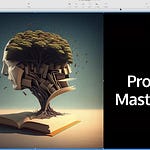Reminder: I am launching an Augmented Intelligence with AI course next Tuesday. Paid subscribers get access to it automatically. (Learn more / Subscribe)
Five years ago, I listened to a Making Sense podcast episode that changed my life.
In it, Sam Harris interviews David Krakuer, the former President at the Santa Fe Institute and a professor of Complex Systems. And Krakauer introduces the idea of cognitive artifacts—tools that shape our cognition. He expands on the idea by introducing two types:

Below is the relevant excerpt from the episode:
Krakauer: Now let’s move into intelligent— or what sometimes gets called cognitive—artifacts. Here’s an example. Your ability to do mathematics or perform mathematical reasoning is not something you were born with. You did not invent numbers. You did not invent geometry or topology or calculus or number theory or anything else, for that matter. They were all given to you if you chose to study mathematics in a class. And what those things allow you to do is solve problems that other people cannot solve.
Numbers are in some sense the lowest-hanging fruit in our mathematical education. So let’s look at numbers. There are many number systems in the world. There are very ancient Sumerian cuneiform numbers about 5,000 years old, some ancient Egyptian numbers. And here is a good example of stupidity in culture. Western Europe, for 1,500 years, used Roman numerals, from about the second century B.C. to 1500 A.D., toward the end of the Holy Roman Empire. Roman numbers are good at measuring magnitude, the number of objects, but terrible for performing calculations. What’s X + V? You know. What’s XII multiplied by IV? It just doesn’t work, and yet for 1,500 years, the human brain opted to deliberate over arithmetic operations using Roman numerals that don’t work. The consequence of that was that for much of their history, Europeans could not divide and multiply. It’s extraordinary, because it’s unbelievably stupid when you realize that in India and Arabia, they had a number system.
It started in India and then moved to Arabia. It was available from about the second century, and that is the system we use today, which can effortlessly multiply and divide numbers. That’s a beautiful example of the interface between culture and our own reasoning. The reason it’s so intriguing is because once I’ve taught you a number system, like the Indian Arabic number system, base 10 number system, you don’t need the world anymore. You don’t need paper anymore to write it down. You can do these operations in your mind’s eye, and that’s what makes them so fascinating. I call objects like that, which were invented over the course of centuries by many, many minds, complementary cognitive artifacts. Their unique characteristic is, not only do they augment your ability to reason in the form, for example, of multiplying and dividing, but when I take them away from you, you have in your mind a trace of their attributes that you can deploy. It’s interesting. That’s probably what’s new in thinking about the evolution of cultural intelligence.
For a long time, psychologists, cognitive scientists, archaeologists, have understood that there are objects in the world that allow us to do things you couldn’t do otherwise. A fork, or a scythe, or a wheel. But there is a special kind of object in the world that not only does what the wheel and the scythe and the fork do, but also changes the wiring of your brain so that you can build in your mind a virtual fork, or a virtual scythe, or a virtual wheel. That, I would claim, is the unique characteristic of human evolution.
Harris: Wouldn’t you put language itself into this category?
Krakauer: Absolutely. The reason I separate them is that many people erroneously assumed, up until quite recently, that mathematical reasoning depended on linguistic reasoning, and was in fact just a special form of it. We now know that’s not true, and that both humans and nonhuman primates are capable of representing number equally well. In fact, when humans perform mathematics, they are using not the linguistic parts of their brain but the parts that represent number, which we share with nonhuman primates.
Harris: What else would you put on this list of complementary cognitive artifacts?
Krakauer: The other example that I’m very enamored of is the abacus. The abacus is a device for doing arithmetic in the world with our hands and eyes. But expert abacus users no longer have to use the physical abacus. They actually create a virtual abacus in the visual cortex. And that’s particularly interesting, because a novice abacus user like me or you thinks about them either verbally or in terms of our frontal cortex. But as you get better and better, the place in the brain where the abacus is represented shifts, from language-like areas to visual, spatial areas in the brain. It really is a beautiful example of an object in the world restructuring the brain to perform a task efficiently—in other words, by my definition, intelligently.
Maps are another beautiful example of this. Let’s imagine we don’t know how to get around a city. Over the course of centuries or decades or years, many people contribute to the drawing of a very accurate map. But if you sit down and pore over it, you can memorize the whole damn thing. And you now have in your mind’s eye what it took thousands of people thousands of years to construct. You’ve changed the internal wiring of your brain, in a very real sense, to encode spatial relations in the world that you could never have directly experienced. That’s a beautiful complementary cognitive artifact. And then some mechanical instruments: You could say that as you become more and more familiar with an armillary sphere or an astrolabe or a sextant or a quadrant, you have to use it less and less. So you build a kind of a simulation in your brain of the physical object. And at some point, in some cases, you can dispense with the object altogether.
The idea of complementary cognitive artifacts resonated, because I remembered moving to NYC to go to NYU and trying to decipher the subway map below.
More than anything, I remembered two turning points:
First time: I remembered the overwhelm I felt the first times I tried to figure out the subway map. I would stare the map for minutes just to figure out what route to take. And, I would still be uncertain.
Mastery: But, over time, I noticed something magical. Whenever I needed to go anywhere in Manhattan, I could quickly visualize the map in my head and then confidently plan which Subway lines to take. I could even estimate how long each trip would take.
The conversation between Krakauer and Harris was also psychoactive because it sparked my curiosity on the topic of augmented intelligence. Right after I listened to the interview, I googled what an Abacus even was. That’s when I came across the video above where kids could accomplish magical mathematical feats simply by using the abacus they had memorized in their head.
It all made me curious about what complementary cognitive artifacts humanity could theoretically invent now if we just had the imagination. As a result of this exploration, I found a few particularly interesting resources that went deeper or adjacent…
I found augmented intelligence videos like the ones above.
In Cognitive Artifacts (1991), Donald Norman introduces the idea of cognitive artifacts for the first time.
In Thought As Technology, independent researcher Michael Nielsen elaborates on cognitive artifacts.
In Human Accomplishment, Charles Murray introduces the idea of meta-inventions which are adjacent to cognitive artifacts.
If you’re interested in the topic of augmented intelligence, I recommend checking them out.
I also became interested in more deeply understanding the pros and cons of each approach…
The Hidden Risks Of Competitive Cognitive Artifacts
In Will A.I. Harm Us? Better to Ask How We’ll Reckon With Our Hybrid Nature, David Krakauer expands on the risks of competitive cognitive artifacts:
Compare these complementary cognitive artifacts to competitive cognitive artifacts like the mechanical calculator, the global positioning systems in our cars and phones, and machine learning systems powering our App ecosystem. In each of these examples our effective intelligence is amplified, but not in the way of complementary artifacts. In the case of competitive artifacts, when we are deprived of their use, we are no better than when we started. They are not coaches and teachers—they are serfs. We have created an artificial serf economy where incremental and competitive artificial intelligence both amplifies our productivity and threatens to diminish organic and complementary artificial intelligence, and the ethics of this sort of mechanical labor are only now engaging the attention of practitioners and policy makers.
We are in the middle of a battle of artificial intelligences. It is not HAL, an autonomous intelligence and a perfected mind, that I fear but an aggressive App, imperfect and partial, that diminishes autonomy. It is prosthetic integration with the latter—as in the case of a GPS App that assumes the role of the navigational sense, or a health tracker that takes over decision-making when it comes to choosing items from a menu—that concerns me.
Said differently, if we extrapolate to a future where competitive cognitive artifacts make all of our decisions while we amuse ourselves, we could end up in a world where we get deskilled and lose our autonomy like the characters in WALL-E:
After my initial exploration of cognitive artifacts, I stopped thinking about them for awhile. While it was a fascinating idea, I had trouble doing much practical with it.
That was until this year when I started to think about how I wanted to use AI…
Cognitive Artifacts Meet AI
Because I had the distinction of complementary vs competitive cognitive artifacts, I immediately saw that AI could be used as both a competitive or complementary cognitive artifact.
For example, when using AI to improve my writing, I could use it in two ways:
Competitive Cognitive Artifact: Aim to have AI automically write or edit my articles with as little involvement from me as possible.
Complementary Cognitive Artifact: Aim to have AI not just give answers, but have it do the following as well:
Compare and contrast different problem-solving approaches and frameworks, hacks, mindsets, paradigms, or process that could be used to get the anwer.
Walk me through how each method could be used in the particular situation.
Walk me through a practice exercise so I can use to practice any underlying concepts I’m missing.
The Case For Using AI To Augment Our Intelligence
While there will be many breakthroughs using AI as both types of tools, I’m most excited by how to use AI to augment human intelligence for a few reasons:
First, I love the idea of using AI to improve my holistic human experience. Imagine, you have a genie in a bottle that will grant you three wishes. Just asking the genie to automate our workflow isn’t especially imaginative or exciting. In many ways, as AI gets better, it may become more and more like a genie, and the idea of thinking more holistically about improving our life is exciting.
Second, almost no one is thinking about intelligence augmentation through the complementary cognitive artifact lens. Oddly, few people are thinking or talking about intelligence augmentation and AI. It’s as if we have a growth mindset of what AI will be capable of and fixed mindset about what humans will be capable of.
Finally, AI will expand the boundary of human potential in exciting ways. I’ve been fascinated by human potential my entire adult life. After awhile, though, a lot of the books on the topic start to repeat themself. AI is something radically novel that will allow us to explore and imagine what we are capable on a level like never before.
For all these reasons, I’ve officially decided to launch an Augmented Intelligence Course that all paid subscribers of this newsletter will automatically get...
Introducing The Augmented Intelligence Course (Starts Next Week)
The purpose of the program is to explore how to use AI to expand our human potential—how to use AI to become smarter emotionally, socially, creatively, behaviorally, and cognitively.
Below is a quick overview of the course:
Start date: Tuesday, July 30 at 11:00am EST
# Sessions: 10
How to access: Become a paid subscriber of this newsletter
What you get from each class session:
Teaching
Proven augmented Intelligence prompt
Practice session using and customizing the prompt
Q&A
After each session, you’ll not only walk away with knowledge and practice using AI to augment your intelligence; you'll also walk away with AI prompts you can customize and use forever.
You can see an example of the types of AI prompts you’ll get access to at Augmented Reading: Learn 10x Faster And Better With AI.
To get the full overview of the course, click on the link below…











